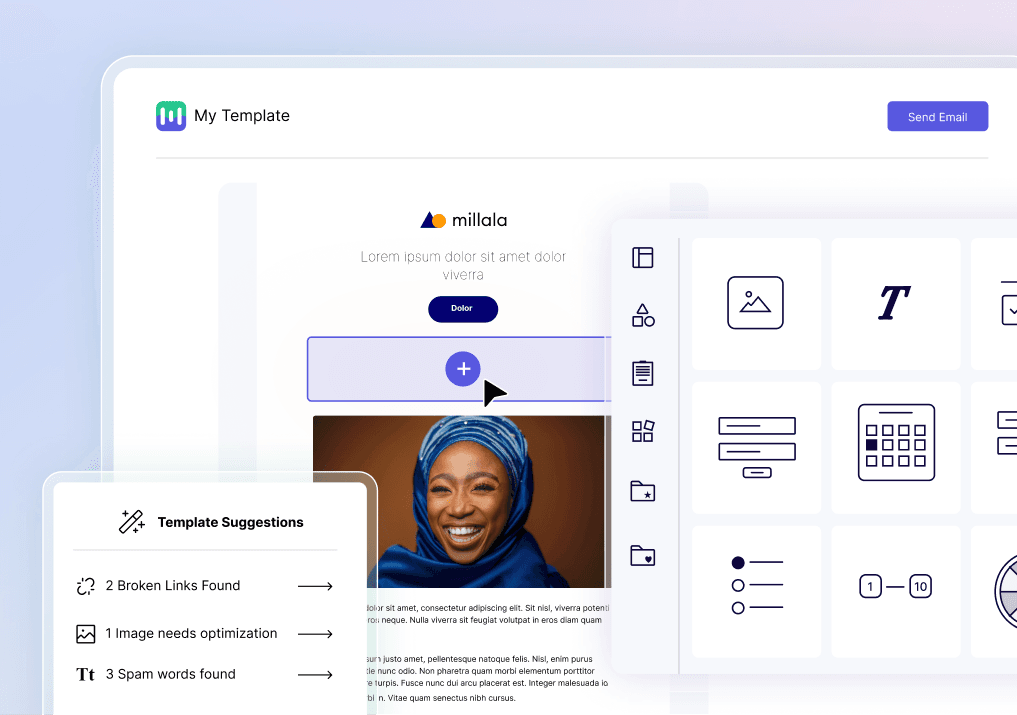Chapter 1
Email Marketing Trends From 2021 That Are Here to Stay
All that transpired in the email marketing world in 2021 and how it will be in 2022
Email marketers face new challenges every day - privacy, spam, automation, competing channels like social media, SMS, and more. The only way to stay on top of it is to understand the entire email landscape and stay up to date on what's happening in the field.
We decided to make this process easy for you. So, we spoke to experts to discover the events and features that shaped the industry last year that will affect the most in the future. And we compiled it all into a list of the most impactful email marketing trends for 2022. Here’s a detailed look at these trends -
The iOS MPP update that shook the email marketing world
We all know how we relied on open rates to measure the success of email campaigns. However, things have changed after the Apple Mail Privacy Protection (MPP) update in 2021! The MPP update allowed Apple users to hide their IP address and privately load all remote content.
So even if a subscriber may not open the email, it might get reported as an open on your ESP dashboard leading to inflated open rates. In short, open rates aren’t reliable going forward.
How do you revise your email marketing post-MPP?
Some email marketers still rely on open rates, but many have started using click and conversion rates to measure the success of their campaigns. Soon most ESPs will start providing ways to identify none- MPP opens. This will help you to segregate reliable and non-reliable opens. We at Mailmodo are already working on bringing out such a feature early this year.
💡 Bonus content: For a more detailed reading on this, here’s a guide for you: Apple Mail Privacy Protection: What It Means For Email Marketers
AMP emails - Redefining emails with interactivity
AMP for emails has come a long way since Google introduced it in 2019. AMP emails have transformed static email designs and replaced them with dynamic emails containing interactive elements like carousels, carts, calendars, app widgets, and more.
Interactive elements reduced the friction for subscribers and made it easier to fill out forms or book meetings within the email. This has led to more clicks and conversions. Many brands have reported nearly three times more conversions than the usual HTML emails.
How brands are leveraging AMP emails: A case study
Razorpay's team wanted to understand their customer’s needs, so they used feedback forms on their website and sent monthly feedback emails. But, they found that customers didn't complete the survey because it redirected them to a different page and took too long to fill.
When looking for a way to fix this problem, they stumbled upon AMP emails and found us. Using Mailmodo, they created and sent AMP emails to keep the entire survey process within the email. And they saw a whopping 257% increase in feedback submissions.
💡 Bonus content: For a more detailed reading on this, here’s a guide for you: AMP for Email
Inclusivity in emails
As a brand, being inclusive is acknowledging that you live in a diverse community and connecting with your audience more deeply. Any apparent discrimination or bias towards a certain group of people can end your brand. The only way to prevent it is by creating for all. Also, remember that being inclusive makes sense because it’s the right thing to do.
How to make your emails more inclusive?
Divide your audience into multiple different segments and customize your email campaigns appropriately for those segments.
When you address people in your email, you can use gender-neutral terms like team, chairperson, or folks.
Use images representing people of different shapes, sizes, races, and religions in your email campaign.
For more tips, please read this detailed guide on inclusive marketing.
Dark mode in emails
The dark mode is a setting that inverts the colors to display a message or text in a dark background instead of a light one. People loved it as it provided a better reading experience in low-light conditions.
But it was a pain for most email marketers because it affected how email clients rendered the emails. The emails not optimized for dark mode have low readability, poor visibility, and lose their visual aesthetics. Because of this, engagement and email conversions took a hit. So, in 2022 be prepared to optimize your emails for dark mode for successful email campaigns.
How to optimize your emails for dark mode?
Use a transparent PNG image of your logo, ensuring a jarring white background won't show behind the logo.
Add a white outline to your logo, so it doesn't blend into the black background and is still visible.
Modify the colors, icons, and CTA buttons to look good in light and dark modes.
To get a deeper understanding, check out our guide on dark mode.
Email accessibility
Accessible emails provide a better reading experience for all readers, even those with disabilities (according to WHO, over one billion people live with some form of disability). In addition, it helps you stand out from your competitors as a more empathetic company. Email marketers are talking more about email accessibility as we march into 2022 and becoming more conscious about subscribers’ experiences.
How to make your emails accessible?
Keep the font and size of the text readable.
Avoid bright saturated colors and have a color contrast of at least 4.5:1, as per WCAG.
Leave some white/empty space between text, images, and CTA.
Provide alt text for images and use semantic code for a better screen reading experience.
For a deep dive into creating accessible emails, refer to our guide.
Emojis in emails
Emojis showed up big time in 2021. We saw them in subject lines, preheader text, and email copies. Emojis help email marketers not look too cold and unapproachable when they send promotional emails and help humanize your emails. And they also help capture the reader's attention and make content more visually appealing.
Here are some of the emojis we see a lot in our inboxes
⭐️️ Promotions, announcements
🔥 Trends or sales
🎁 Personalized birthday emails
😍 Emails expressing gratitude, thank you emails
✨ Announcements, product launches, and updates
🎉 Celebratory emails
Also, we have a quick guide ready to help you include emojis in your emails.
Email personalization humanization
Today's audience is smarter than ever and expects personalization at every step of communication - it can no longer set you apart. It is expected from you. Brands must step up and connect to the audience on a deeper, human-to-human level.
How to humanize your emails?
When you write your emails, keep the text simple and conversational as you would if you sent them to your friend.
Personalize the emails to include your subscribers' names in the email subject line or copy. Even the smallest details can help you connect with your readers.
“Personalisation! We all know it. Gathering data from users at sign-up ensures you'll get it, once they're signed up, it's an uphill battle you won't win easily. It also ensures you get more meaningful sign-ups, rather than the one-off for a discount!”
- Jen Neal, Email Marketing Manager, Stitch & Story
“Using a receiver's first name is not enough - From your segmentation strategy and tone of the communication to send-time-optimization strategy, every aspect should reflect how much you value an individual customer.”
- Aquibur Rahman, CEO, Mailmodo
“My advice for young and budding email marketers going into 2022 would be to improvise the personalization of the email copies that you send out. These improvisations need to be based on the pandemic trends of a particular demography. This will help you gain more attention and higher conversion rates from email marketing in 2022 and beyond.”
- Sanket Shah, CEO, Invideo
Chapter 2
Top 5 Email Marketing Pitfalls of 2021 (and How to Overcome Them)
Mishaps and blunders that marketers suffered in 2021 and an exclusive Mailmodo insight on preventing them in 2022
At Mailmodo, we work with 100+ clients daily and help them send thousands of emails to their subscribers. Our product managers, customer success folks, and content strategists know what makes an email work, what problems email marketers face, and some of the most overlooked mistakes when an email campaign goes live.
As part of this report, we interviewed our core team extensively to understand what goes on behind the scenes in an email marketing team and compiled their insights into actionable tips.
Here are the top 5 email marketing mistakes that marketers committed in 2021.
1. Not warming up your domain before sending massive campaigns
Email marketing is not a plug-and-play process; you can't just log in, create a campaign, and send it to thousands of people immediately. If you do, it can make you look spammy to mailbox providers, and ruin your domain reputation, and hurt email deliverability.
Here’s what you can do to ensure that it doesn’t happen to your email domain -
“Warm up your domain by sending your email campaign to a small portion of your subscribers. Then, increase the audience size and frequency of the warm-up emails gradually."
- Pratik, Customer Success at Mailmodo
2. Sending the same campaign to everyone on your list
Most newbie email marketers make this mistake: they create one or two monthly campaigns and send them out to everyone on their list without any strategy.
Such emails, however, are a waste of time and effort as they won't be relevant to everyone on the list. Here’s what you can do instead -
Segment your subscribers based on their age, gender, location, interests, hobbies, etc., and group them into different segments. Your segments can be based on other data points that are more relevant to your brand.
Create and send emails appropriate for each segment rather than sending subscribers the same generic email.
After segmentation, you need to personalize the emails for your subscribers with proper context.
“Better segmentation, personalization, intent-based and contextual communication will be the key to increasing the email channel performance in 2022.”
-Baradhwaj R, Marketing Director, MoEngage
3. Sending emails to users who don't open or engage with the emails
If you keep sending to people who don't open your emails, they will likely get annoyed and mark your email as spam. Also, if subscribers do not open your emails, it sends a bad signal to ISPs and email clients and will damage your reputation.
So, to avoid getting marked as spam, you need to -
Clean your email list regularly using a sunset policy.
Stop sending emails to people who don't engage with your emails, and keep them on a suppression list to avoid accidentally sending them emails.
“Getting a sunset policy doesn’t seem like an urgent requirement for your email marketing campaign, but in the long run, it’s one of the most vital ones. You don't want to spam people. If someone is not interested in your services after all your efforts to woo them with the best offers, maybe it's time to let them go. Your list hygiene is what will make or break your email marketing. And for that, sunsetting subscribers at the right time is essential.”
- Apurv Gupta, Co-founder, Mailmodo
4. Sending campaigns in high volumes all at once
When people send large volumes of emails all at once, it might increase unsubscribe rates and spam complaints and ultimately damage your domain's reputation. Thus, you must split your list into a few groups and send your campaigns to small groups simultaneously.
Moreover, ESPs provide a way to automate the batch-sending process using a fragmented scheduler tool. You can configure it once, and the emails will be sent automatically.
“Email marketing needs discipline and planning. Sending unplanned email blasts without considering your IP/domain reputation could be disastrous. You need to segment your lists, and plan your blasts to make the highest impact. I have seen numerous email teams failing because they think email marketing is only about setting up an ESP and sending emails to a list.”
- Kirti Krishan, Product team, Mailmodo
5. Relying heavily on images (Extremely high image-to-text ratio)
When an email is image-heavy, and the text is in the images rather than the email, the email will not be accessible. So, if your email doesn't load, the reader will not understand anything in your email.
Best practice: Keep the image-text ratio in your email to 60:40 or 80:20 maximum. It ensures that the email is still readable if the image fails to load.
“My advice for email marketers going into 2022 is the same as it was in 2012 - Treat your email subscribers with respect, and they will treat you with respect.
The two things that all companies can do to give themselves a competitive advantage are 1) stop sending unwanted emails and 2) send more relevant emails to the right people. All other tactics and strategies are just extensions of these two core principles.
Don't be afraid of A/B testing; learning the best way to communicate with your customers is critical because they are on their guard when dealing with internet marketers. That means the days of "buy my product" emails are over. You need to offer something really valuable to them - something they'll find useful, helpful, or entertaining in some way.”
- Khamis Maiouf, CEO, Book of Barbering
Chapter 3
Insights from State of Email Survey 2022
Survey results of over 250 marketers and what it indicates about the State of Email
How was this survey conducted?
This survey was conducted through email campaigns using Mailmodo. We created interactive survey forms that surveyors could fill out inside the email.
We sent targeted emails to our customers, subscribers, well-wishers, and stakeholders, used our social media platform, and promoted the survey through our monthly newsletter. We also reached out to industry stalwarts and who’s who of email to get their invaluable advice.
We collected data from over 250+ marketers with the help of a questionnaire that was carefully converted into insights and drafted into this report by our in-house team.
What were the survey topics?
Our team created a questionnaire comprising 50 questions covering email marketing objectives, deliverability, infrastructure, email design and development, email marketing strategy, email copies, open rates/slots, and AMP emails.
The questionnaire was made conditional using Mailmodo’s conditional multi-step forms, which led the respondents only to the questions related to their expertise. For example, if the respondent were a copywriter, she would be asked questions belonging to the “Email Copy” section.
About our respondents
We reached out to email marketers, email developers, email designers, campaign managers, deliverability experts, growth marketers, heads of marketing teams, and directors of growth/marketing agencies. Our surveyors hailed from over 250 B2B and B2C companies like Stripe, InVideo, Netcore cloud, MoEngage In, The Media Ant, Xoxoday, Leena AI, and Eatwith.

What did we learn from our survey?
Let’s dive deep into what we learned from our survey and how you can use this data to improve your email marketing.
Email marketing objectives
The email marketing objectives of our respondents were wide and varied, and we asked them about them. Here’s what they told us -
The main objectives for every email marketer are product awareness and promotion, followed by acquisition and newsletters. According to the survey, these trends will remain the same in 2022. In 2022, however, email marketers seem keen on conducting surveys and data collection through email marketing.

Deliverability and infrastructure

1. Nearly 16% of the surveyors do not warm up their domains before sending emails.
And that's unfortunate because a proper domain warm-up is essential to getting all of your emails delivered, as, without warm-up, your emails might end up in spam.
💡 What you should do
Warm up your domain to send emails for at least 30 days before you start sending massive campaigns.
Start by sending emails to a few people and gradually increasing the number of emails you send daily.

2. 52.6% of the surveyors increased their daily send by 1.5X in the warm-up phase.
It means that if they sent 100 emails on day 1 of warm-up, they increased the number to 150 emails on day 2.
💡 What you should do
Increasing the volume by 1.5X is a tested method to warm up the domain successfully. There's no hard and fast rule for sticking to 1.5x; however, try and keep the factor below 2X.

3. The average inbox placement rate ranges between 70-100% across industries.
Inbox placement rate (IPR) is a measure of email deliverability used to determine how many of the emails sent end up in the subscriber's inbox.
💡 What you should do
Target users with good open rates and brand affinity.
Ensure your IPs don't hit spam traps/be listed in DNSBLs.
Make sure all the authentication techniques, like DMARC, pass consistently.

4. 57% sent emails from a dedicated IP set-up.
In a dedicated setup, the IP address is used by one sender, whereas in a shared setup, multiple users use it to send emails. Most brands want to build their own email infrastructure.
💡Dedicated vs Shared IP
With a dedicated IP, you aren't susceptible to corrupt email practices followed by other brands. A dedicated IP also enables you to have a dedicated PTR (hostname) for your IPs so that you don't have any deliverability issues with ESPs like Hotmail & iCloud.

5. 29.4% of the surveyors said that they do not track the SNDS reputation of their IP address.
Smart Network Data Services (SNDS) is a free service that Microsoft provides its users to give them insight into their IP address reputation in the Outlook.com system and how their subscribers rate the email they receive.
💡 What you should do
Use this data to keep your list clean and monitor any unusual behavior.

6. 29.4% don't track their domain reputation, while 17% don't monitor IP reputation.
Gmail spam filters look at the sender domain and envelope domain reputations along with IP reputation and spam rates to decide if your email should land in the inbox or spam.
💡 What you should do
Regularly check your IP and domain reputation on Google Postmaster.
If you see a downtrend in reputation, trace the root cause, fix it and continue monitoring.
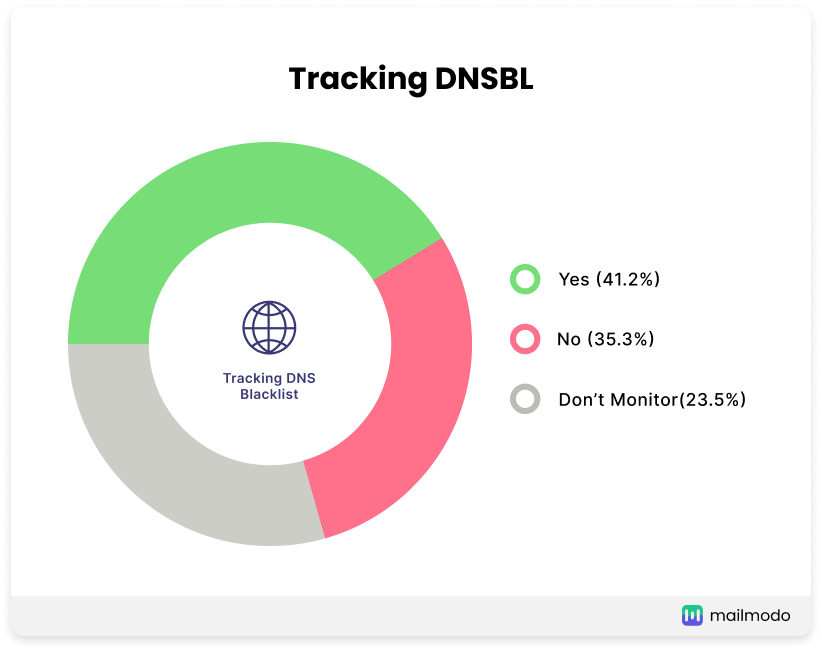
7. 23.53% of the surveyors said they do not track their DNSBL(Domain Name System Blacklist).
DNSBL is a service mailbox providers use to check whether a sender’s IP address is blacklisted. If you are blacklisted, mailbox providers will stop your email from reaching the receiver's inbox.
💡 What you should do
Automate DNSBL alerts so that you get to know if you get blacklisted.
If you get blacklisted, submit a request to the operator to remove you from the list.

8. 68.42% of them have ensured their setup is DMARC compliant.
DMARC ((Domain-based Message Authentication Reporting and Conformance) is a protocol used to authenticate an email. DMARC is also required for whitelisting AMP emails.
💡 What should you do
Set up DMARC to safeguard against email phishing, spoofing, and other unauthorized uses.
Monitor the DMARC reports sent to the email address.
Design/Development

1. 66.7% of the surveyors use drag-and-drop editors for creating their email templates.
With drag-and-drop, one can effortlessly edit, scale, and automate email campaigns with the help of ESP. Moreover, dependence on developers is eliminated.
💡 What you should do
If you are coding your emails from scratch, you might experiment with an ESP using prebuilt templates and check the ROI.
ESPs also allow you to automate email journeys, add personalization and send transactional campaigns.
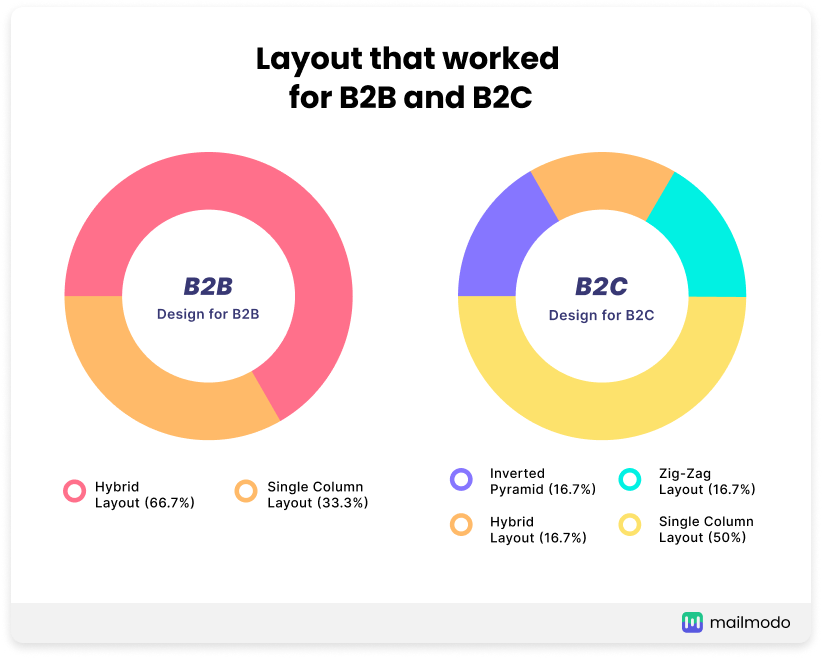
2. 67% of the surveyors from the B2B sector said that the hybrid layout worked best for them.
A hybrid layout makes organizing a lot of content easy, which is likely why B2Bs use it to create emails. Check out our guide on email layouts to find out which one is the right for your needs.

3. 67% of the surveyors use GIFs in their email
GIFs are moving images used to make emails more engaging. And engagement is one of the KPIs of a good campaign. So, as we predicted in the first chapter of this report, GIFs will dominate emails in 2022.

4. 40% of the surveyors said they don't design their emails for dark mode.
Readers have a bad reading experience when they see a non-dark mode email when they set dark mode, and they will delete it rather than read it. So, 40% of the surveyors miss out on potential engagement and conversions.
💡 What you should do
Use a transparent PNG image of your logo with a white border.
Choose shades that work well in both light and dark modes.
Learn more about how to optimize your email for dark mode.

5. 80% of the surveyors consider accessibility while designing their emails.
A large percentage of the surveyors create accessible emails for their audience, showing that they care about all of their users and reading experiences.
💡 What you should do
Avoid bright saturated colors and low color contrast.
Leave some white/empty space between text, images, and CTA.
Provide alt text for images for screen readers.

6. 6.7% don't check to see if their email design is responsive on all devices.
Responsive email design is when the email is optimized to render well on all devices like laptops, mobile, and tablets.
Email marketing strategy/Ops
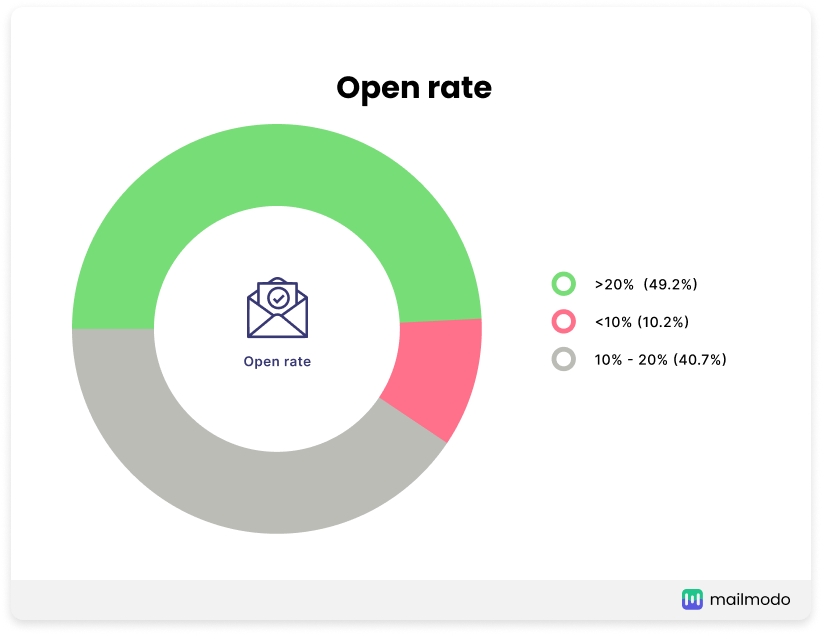
1. The average open rate recorded by the surveyors is greater than 20%.
20% is pretty good because the open rates for email are usually around 12-25%, depending on the industry.

2. 47.6% of the surveyors have used Send Time Optimization for more than 50% of their email campaigns.
Send Time Optimization (STO) is an AI-driven add-on feature that uses machine learning to analyze your contacts’ actions within the email to identify the best time to send the email.
💡 What you should do
Go to your chosen ESP and turn on the STO feature.
If unavailable, focus on testing your campaigns for optimum send time.

3. 50% of the surveyors segment their list randomly after A/B testing campaigns based on open rates.
A/B testing is when you send two versions of the same email with a different subject line or other email elements to determine which version performs well with your audience.
💡 What you should do
If you are using the open rate metric, you should segment your audience based on email activity, like open or non-opens.
Test one parameter of the email at a time.

4. 67.7% of the surveyors have not conducted an RFM analysis of their customers.
RFM (Recency, Frequency, and Monetary) is the easiest form of segmentation based on user activity data.
💡 What you should do
Segment engaged and unengaged users based on RFM data. E.g., customers who have responded in the last 30 days can be a segment.
Create different email strategies for different kinds of segments.
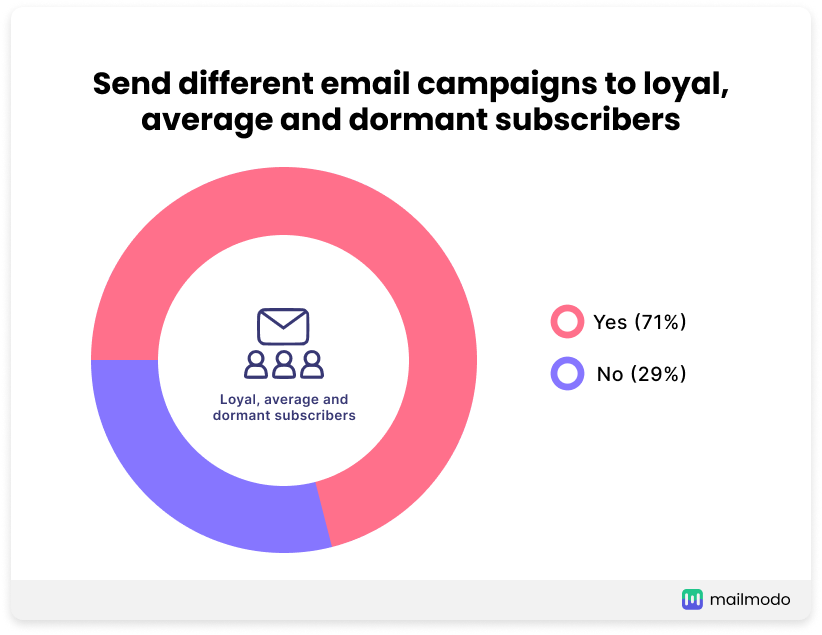
5. 71% of the surveyors said they send different email campaigns to their loyal, average, and dormant subscribers.
Sending the same emails to all subscriber segments is not a good idea, as every step of the funnel needs to be nurtured with different messaging.
💡 What you should do
Segment your subscribers based on their journey in the funnel.
Send a re-engagement email to your non-engaged subscribers.
If they still don’t engage, remove them from your list.
“Provide value with every email. We include sample marketing insights from our newsletter even in our subscription confirmation message. It’ll increase brand affinity, open rates, and conversion rates and decrease unsubscribe rates.”
- Neal O'Grady, Co-Founder, Demand Curve
“Email marketing is a relatively inexpensive form of marketing, but it does come with a risk. Email marketers must ensure they keep up with the increased scrutiny by regulators and provide clear consent to users before sending them any emails.
The regulatory environment has become increasingly complex over the last few years, and this trend is expected to continue. In addition, to comply with any new legislation, email marketers must proactively monitor existing regulations to avoid potential penalties or lawsuits from consumers and regulators.”
- Ryan, COO, Luck Luck Go
Email copies/Copywriting
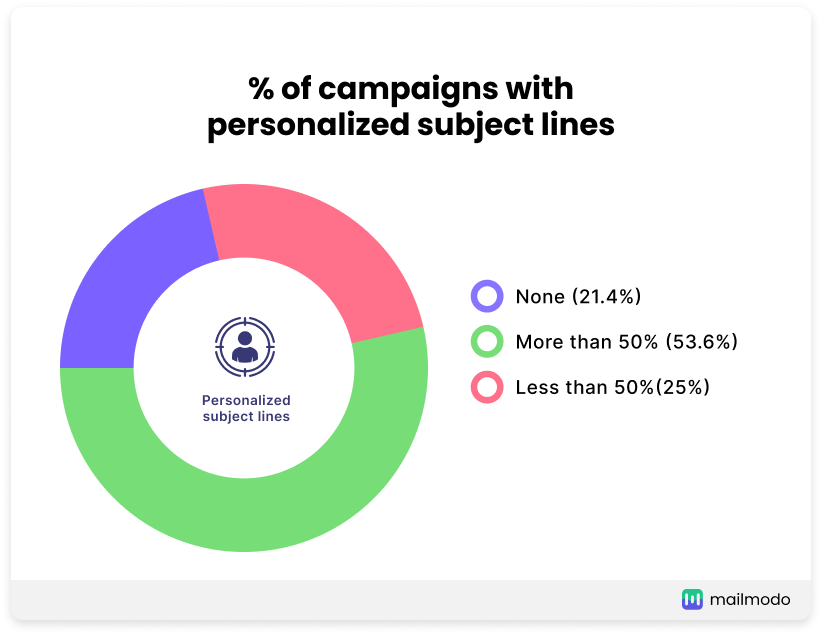
1. 53.6% of the surveyors sent personalized subject lines in more than 50% of their emails.
Personalized subject lines can be anything from mentioning the user's name in it or be completely customized for a segment of your audience. It makes people want to open your emails.
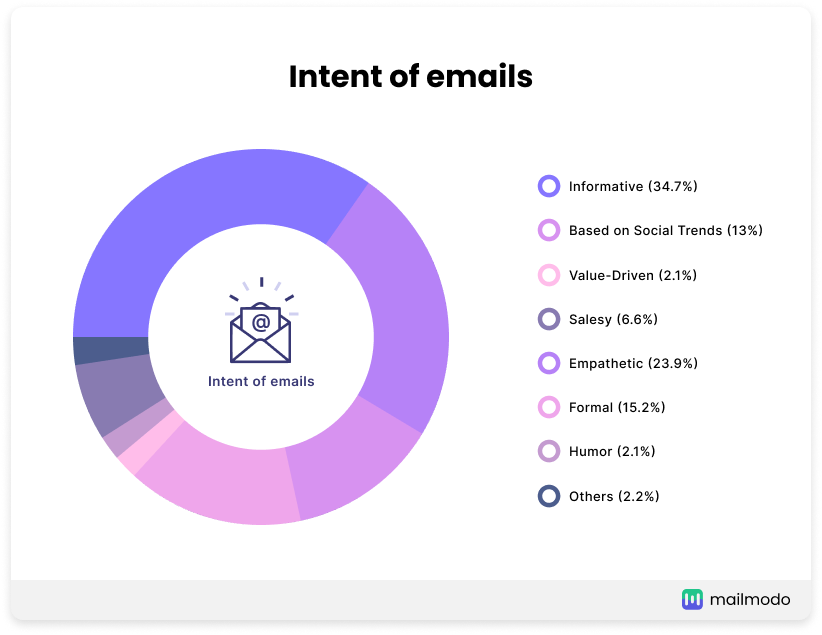
2. 33.3% of the surveyors said that most of the emails they sent were intended to be informative.
Informative copies are exact and provide all the information a consumer needs to understand about the company/product. Value-driven content might seem similar to informative, but it refers to emails with actionable information that can help readers directly.

3. 42% of the surveyors said that an actionable CTA was the one that worked best in 2021.
A call to action becomes actionable when you mention what action you would like your users to take. An actionable CTA leaves no room for misinterpretation, so relevant people are likelier to click on it.
💡 What you should do
Explore different CTAs to find what works best for you.
To write an actionable CTA, be clear on what action you want subscribers to take.
Read more about email CTA and how to use them to get more clicks.

4. 37.5% of surveyors said they don't include a CTA in their email signatures.
The purpose of the CTA in the signature is to entice readers to take an additional action like clicking on a video or website link. CTA in the signature has both supporters and detractors.
💡 What you should do
Test if CTA in signature works with your audience.
If you choose to include a CTA in the signature, ensure that it is a compelling one and not click-baity.

5. 54.5% of the surveyors said they get clicks from their footer.
Marketers link their social media or website in the email footer. This is an additional CTA apart from the email's main message and is usually used for brand awareness or offer placement.
“Treat your subscribers like A list of friends. The future of email marketing is personalisation. Too many emails are generic and do not offer any value to the reader. So no matter what industry you’re in, make sure that you are writing to the subscribers as you write to a friend. By doing this, you will stand out from the crowd and people will feel more compelled to open your emails. Make sure you are delivering on your promises.”
- Mohamed Hassaan, CEO, Style Recap
“Understanding your audience is important. Once you know where they are in their customer journey, and what they are looking for, you can craft a better email marketing strategy. With personalisation and automation you can time it better.”
- Mithun Jhawar, Associate Director - Marketing, SplashLearn

6. 68.2% of the B2C and 50% of B2B surveyors use social media links in their email footer.
Linking your social media profiles in the footer has pros and cons. It might encourage your subscribers to visit and even follow your socials. On the other hand, it might increase the link density in your email, which might impact inbox placement.
💡 What you should do
Explore different footers and see which goes well with your audience since links in the footer have both pros and cons.
You can add a link to your website so people can check it out after reading the email and validate your brand.
Please read our guide on email footers to know more about it.
“Don't reveal everything in subject lines.”
- Satrujitmishra, Klaviyo Expert
Open rates/slots

1. 71.4% of the surveyors saw a rise in open rates in 2021 compared to 2020.
The rise in open rates could be because of their email campaigns, but it is also likely that the rise could be because of the Apple MPP update.

2. 56.8% of our survey respondents found an increase in mobile opens in 2021.
It indicates that more and more people have been using mobile devices to check their email in recent years. And the numbers will only keep increasing because it's easy to use on the go.

3. 41.2% of the surveyors said that the open time slots have broadened and have extended into the night.
A major factor for this might be the ongoing pandemic. We see a change in the open time slots with everyone at home.
💡 What you should do
Experiment and find out the best time to send emails.
Take care of time zones, office hours, and holidays while sending campaigns.
“Keep minimal content on promotional emails and always have a call to action button.”
- Bilal Chaglan, CEO, BotSpace
“Value is everything. Why open? Why click? Vapid, lazy CTAs waste everyone’s time (like “checkout”). Stop that. Put yourself in the reader's shoes. Clearly explain what is in it for them.”
- Kate Bradley Chernis, Co-founder & CEO, Lately.ai
“Design emails for mobile in 2022. Our best automated emails are the ones that don’t look like one - maximum three lines.”
- Monika Adarsh, Senior Marketing Manager, Beaconstac
AMP emails
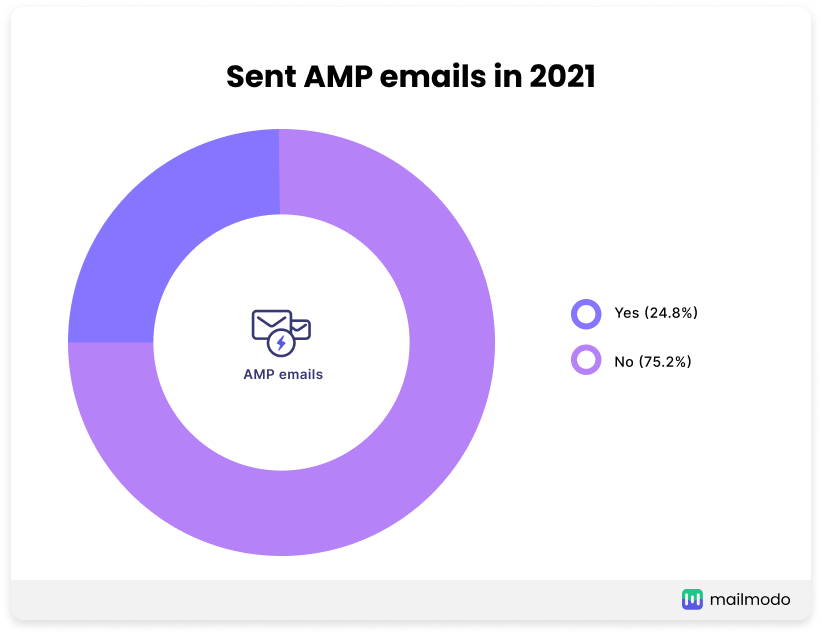
1. Only 24.% of the surveyors sent AMP emails in 2021.
75.2% of people have missed out on all the benefits of sending an AMP email in 2021. AMP provides a better experience for readers, making it easy to fill out forms or surveys within the email rather than on a different website.
Reasons for not using AMP emails

People don't seem to create and send AMP emails because they are unaware of what it is and how it can benefit their email marketing campaigns.
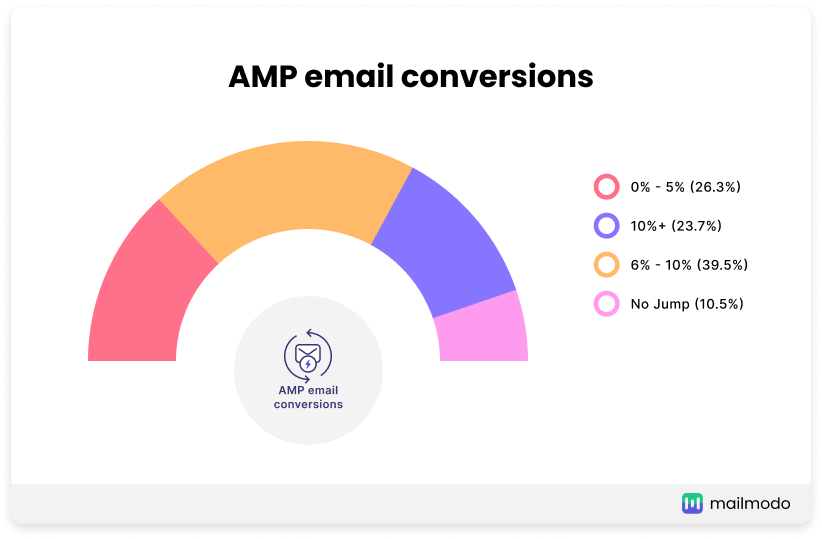
2. 23.7% of the people who did use AMP emails found a nearly 10% increase in their email conversions.
This shows that AMP emails could help reduce the friction within the email and get more people to do an action mentioned in the email, like filling out a form or booking a meeting.
Read our guide to find out more benefits of AMP emails.
Here are some ways our surveyors have used AMP in their emails in 2021.

The surveyors who sent AMP emails last year seem to have experimented with all sorts of use cases of AMP, like conducting surveys, booking meetings, cart abandonment emails, etc.
Note: When you create AMP emails, create an HTML fallback so that people will see the HTML version of the email if AMP doesn't render.
Here are some of the AMP email components/features our surveyors found the most useful.

Forms and carousels were the two most useful AMP features, followed by dynamic updates and calendar booking features.
Chapter 4
Advice for email marketers going into 2022
" 1. Know your audience well. Prioritize their success before your own.
The subject line is still the most important element of your email.
With Apple's new privacy settings that impact what information companies can track, open rate as the key metric of your email campaign performance could be a thing of the past.
Use AI for your email campaigns.
Make emails as interactive as possible.
- Chirayu Akotiya, Director- Product & Growth, Leena.AI
“My advice for email marketers going into 2022 is to be very clear about the value you are providing your email subscribers. If you're selling a product or service, you need to show the results your customers get from using it. The emails should be short, simple, and to the point, with no frills or fluff. The best email content will be actionable, personalized, and relevant to the specific person receiving it. The more you know about your audience (and their interests), the better your open rates will be.
People are still getting a ton of spam every day. Even if you have a great list and take really good care of that list, there's still a high likelihood that people will think it's spam. You have to make sure it's not spammy.”
- Ann Young, CEO, Fix The Photo
“A major objective of any email marketing campaign is to increase revenue. Over the past couple of years, marketers have realized that one of the most effective ways to do this is by completely personalizing their email campaigns.
If email marketing campaigns are not personalized, it may result in anything from diminished mailing lists to the campaign falling apart altogether because its costs skyrocket. So, the personalization of emails will be a key trend for 2022.”
- Glen Carroll, Managing Director, Clicks Marketing
“If leads are nurtured well through email marketing, then it will work.”
- Ritesh Soni, Founder, RaSu Creative
“Focus on automation. Optimize for clicks.”
- Will Pearson, Scalero
“My advice for email marketers is to incorporate personalization and segmentation. Get to know your audience and create emails that are tailored to them. For example, in onboarding, don't send everyone the same emails. Instead, create different journeys based on factors like their plan type, how they've interacted with the product, what emails they've clicked on, etc. Customers want to feel like you understand them and provide valuable content.”
- Cassandra Highbridge, Unstack
“My main advice for email marketers is to focus on your list health. It means focusing on the subscribers you currently have and ensuring you are continually working on converting them into customers. Test subject lines, create new content relevant to your subscribers, and continue providing value to them outside sales.
Email marketing is also a great way to build relationships with customers. If you can build a relationship with your subscribers over time, they will become more likely to purchase from you because they trust you!
Finally, I would recommend developing an effective strategy for nurturing your leads. Nurturing involves sending emails with a higher engagement than your typical promotional emails. This can help ensure that when the time comes for your customer to purchase, they come back to you first.”
- Anders Rydholm, CEO, PrimetimePokemon
“The most important aspect of email marketing is to have relevant content for the target audience.”
- Vishal Aneja, Director, Mercomz
“Short and direct. There are a ton of emails being sent and we have noticed that long emails, no matter how well written, are not being read. Make sure you are delivering quick and helpful content to your audience.”
- Garrett Brock, VP of Marketing, Stukent
“For 2022, businesses should understand 3 core principles for effective
email marketing:
- Long-term relationships are very profitable.
Email marketing aims to build a list of super fans that buy more, buy more often, and tell their friends to buy. A relationship-focused email strategy will get you there.
- Campaign mixing helps you make offers without burning your email list.
There are unlimited implementations of email marketing. To maintain the
health of your list while generating revenue, you should mix up the sending
strategies. The three core sending categories are: relationship emails,
offer emails, and newsworthy emails.
- Words over design.
The biggest mistake brands make is believing that the email design drives the results. Your customers want to buy products that solve problems. We communicate problems and solutions with words.
If you follow these principles, your revenue will increase and stay there.”
- Kevin Izevbigie, Founder, S2 Digital
"Customer interviews and surveys are a goldmine for learning more about your customers. But your customers are busy — so getting them to schedule a meeting or answer a questionnaire is super-hard. When you embed surveys and calendars in your emails, it reduces friction and feels a lot more natural to take the next step.”
- Jitesh Patil, Content & SEO Specialist, Toggl
“Email marketing yields results in the long-term just like SEO. It makes you earn 5x of your investment.”
- Mohan K, SEO Specialist, Loop Health
“Keep emailing till a better option is in sight, which seems like a long time away.”
- Suresh Ramachandran, CEO & COO, Eye-Q Films
“The top tactics used by email marketers to improve performance in 2021 is message personalization, mobile-friendly optimization, audience segmentation, and A/B testing.
Crafting a successful marketing email requires careful consideration of every component, i.e., subject line, copy, images or gifs, CTA, the time you send your email, and the devices on which your recipient may view your email. Everything matters.
Since promotional emails are the most common email type that marketers are investing in, AMP for email could prove to be a gamechanger once more, ESPs support the sending of AMP emails. With the ability to create a website-like experience enriched with dynamic content within an email, I believe interactive email has the potential of exponentially increasing audience engagement, retention, and conversion.”
- Richard Canday, Founder & CEO, Content Cliniq
“Just be brave and do lots of experiments.”
- Veselin Syarov, Email & Push Marketing Communications Manager, iCard
“Write less copy, lean into the design and interactive emails more and more.”
- Kelsey Johnson, AWeber
“The most important thing email marketers should consider is the constantly evolving digital landscape. It is crucial to stay up-to-date with the current trends and constantly experiment with new content formats and tactics.
People's expectations constantly change, so you must keep up with them by constantly innovating your content strategy. After all, your goal should be to meet people’s expectations by creating an email campaign that satisfies their needs.”
- Jonathan Tian, Founder, Mobitrix





































